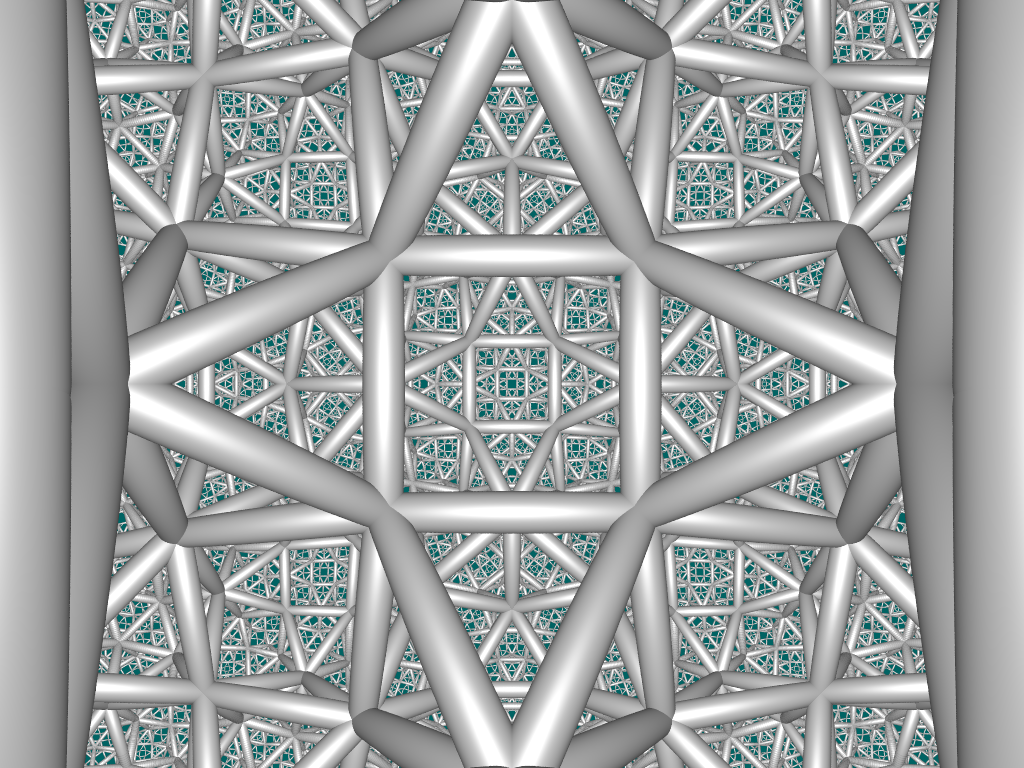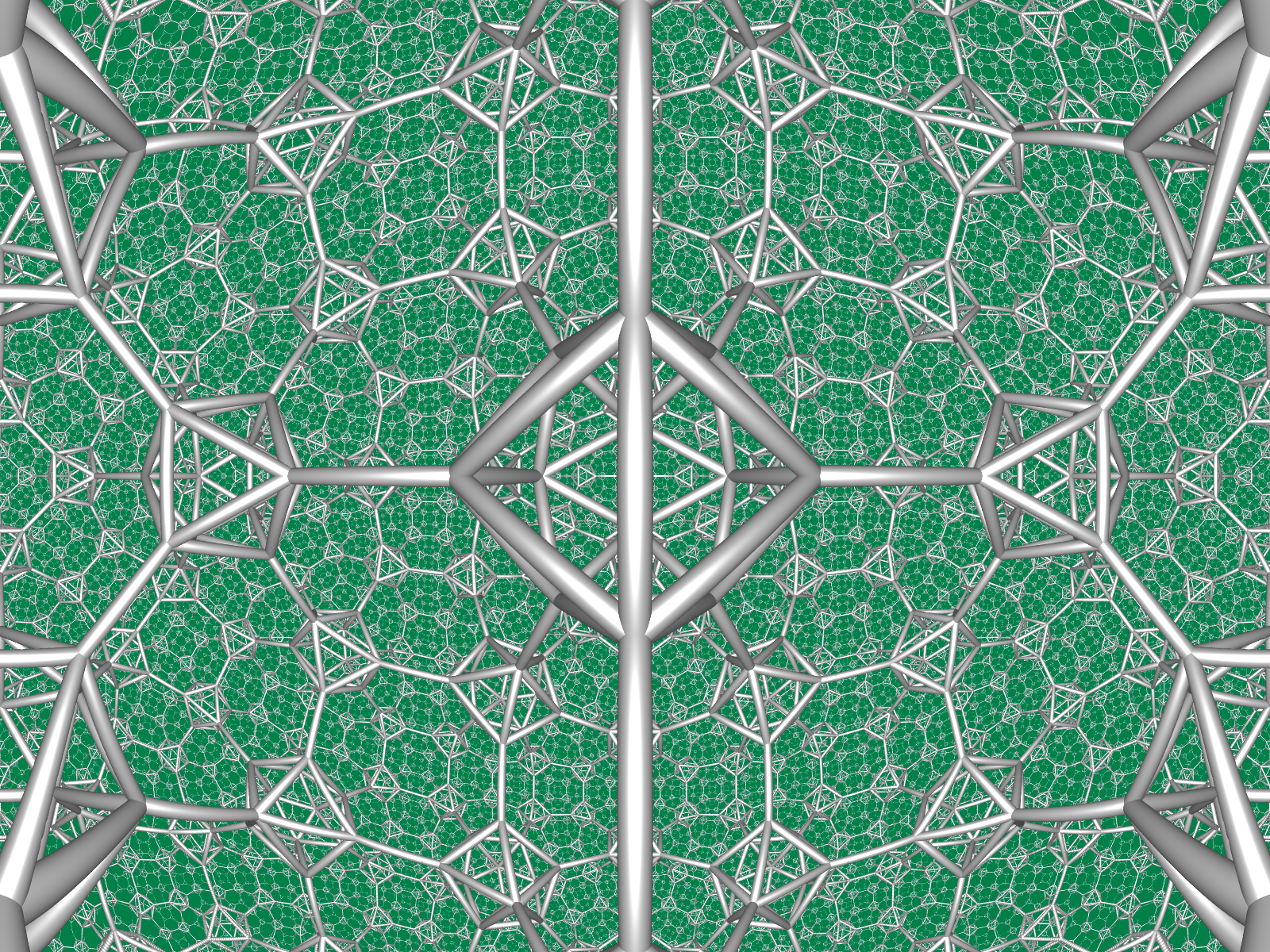omnitruncated order-5 cubic honeycomb on:
[Wikipedia]
[Google]
[Amazon]
In hyperbolic geometry, the order-5 cubic honeycomb is one of four compact regular space-filling tessellations (or honeycombs) in


 There are four rectified compact regular honeycombs:
There are four rectified compact regular honeycombs:
 It can be seen as analogous to the 2D hyperbolic truncated order-5 square tiling, t, with truncated square and pentagonal faces:
:
It can be seen as analogous to the 2D hyperbolic truncated order-5 square tiling, t, with truncated square and pentagonal faces:
:  It is similar to the Euclidean (order-4) truncated cubic honeycomb, t, which has octahedral cells at the truncated vertices.
:
It is similar to the Euclidean (order-4) truncated cubic honeycomb, t, which has octahedral cells at the truncated vertices.
:




 It is analogous to the 2D hyperbolic rhombitetrapentagonal tiling, rr, with square and pentagonal faces:
:
It is analogous to the 2D hyperbolic rhombitetrapentagonal tiling, rr, with square and pentagonal faces:
: 









hyperbolic 3-space
In mathematics, hyperbolic space of dimension n is the unique simply connected, n-dimensional Riemannian manifold of constant sectional curvature equal to -1. It is homogeneous, and satisfies the stronger property of being a symmetric space. The ...
. With Schläfli symbol it has five cubes around each edge, and 20 cubes around each vertex
Vertex, vertices or vertexes may refer to:
Science and technology Mathematics and computer science
*Vertex (geometry), a point where two or more curves, lines, or edges meet
*Vertex (computer graphics), a data structure that describes the position ...
. It is dual
Dual or Duals may refer to:
Paired/two things
* Dual (mathematics), a notion of paired concepts that mirror one another
** Dual (category theory), a formalization of mathematical duality
*** see more cases in :Duality theories
* Dual (grammatical ...
with the order-4 dodecahedral honeycomb.
Description
Symmetry
It has a radial subgroup symmetry construction with dodecahedral fundamental domains: Coxeter notation: ,(3,5)* index 120.Related polytopes and honeycombs
The order-5 cubic honeycomb has a related alternated honeycomb, ↔ , with icosahedron and tetrahedron cells. The honeycomb is also one of four regular compact honeycombs in 3D hyperbolic space: There are fifteen uniform honeycombs in the ,3,4 Coxeter group family, including the order-5 cubic honeycomb as the regular form: The order-5 cubic honeycomb is in a sequence of regular polychora and honeycombs with icosahedral vertex figures. It is also in a sequence of regular polychora and honeycombs withcubic
Cubic may refer to:
Science and mathematics
* Cube (algebra), "cubic" measurement
* Cube, a three-dimensional solid object bounded by six square faces, facets or sides, with three meeting at each vertex
** Cubic crystal system, a crystal system w ...
cells
Cell most often refers to:
* Cell (biology), the functional basic unit of life
Cell may also refer to:
Locations
* Monastic cell, a small room, hut, or cave in which a religious recluse lives, alternatively the small precursor of a monastery w ...
. The first polytope in the sequence is the tesseract
In geometry, a tesseract is the four-dimensional analogue of the cube; the tesseract is to the cube as the cube is to the square. Just as the surface of the cube consists of six square faces, the hypersurface of the tesseract consists of eig ...
, and the second is the Euclidean cubic honeycomb
The cubic honeycomb or cubic cellulation is the only proper regular space-filling tessellation (or honeycomb) in Euclidean 3-space made up of cubic cells. It has 4 cubes around every edge, and 8 cubes around each vertex. Its vertex figure is a reg ...
.
Rectified order-5 cubic honeycomb
The rectified order-5 cubic honeycomb, , has alternating icosahedron andcuboctahedron
A cuboctahedron is a polyhedron with 8 triangular faces and 6 square faces. A cuboctahedron has 12 identical vertices, with 2 triangles and 2 squares meeting at each, and 24 identical edges, each separating a triangle from a square. As such, it ...
cells, with a pentagonal prism vertex figure.

Related honeycomb
Truncated order-5 cubic honeycomb
The truncated order-5 cubic honeycomb, , hastruncated cube
In geometry, the truncated cube, or truncated hexahedron, is an Archimedean solid. It has 14 regular faces (6 octagonal and 8 triangular), 36 edges, and 24 vertices.
If the truncated cube has unit edge length, its dual triakis octahedron has edg ...
and icosahedron cells, with a pentagonal pyramid
In geometry, a pentagonal pyramid is a pyramid with a pentagonal base upon which are erected five triangular faces that meet at a point (the apex). Like any pyramid, it is self- dual.
The ''regular'' pentagonal pyramid has a base that is a r ...
vertex figure.
 It can be seen as analogous to the 2D hyperbolic truncated order-5 square tiling, t, with truncated square and pentagonal faces:
:
It can be seen as analogous to the 2D hyperbolic truncated order-5 square tiling, t, with truncated square and pentagonal faces:
: 
Related honeycombs
Bitruncated order-5 cubic honeycomb
The bitruncated order-5 cubic honeycomb is the same as the bitruncated order-4 dodecahedral honeycomb.Cantellated order-5 cubic honeycomb
The cantellated order-5 cubic honeycomb, , has rhombicuboctahedron, icosidodecahedron, and pentagonal prism cells, with a wedge vertex figure.
Related honeycombs
It is similar to the Euclidean (order-4)cantellated cubic honeycomb
The cubic honeycomb or cubic cellulation is the only proper regular space-filling tessellation (or honeycomb) in Euclidean 3-space made up of cubic cells. It has 4 cubes around every edge, and 8 cubes around each vertex. Its vertex figure is a re ...
, rr:
:
Cantitruncated order-5 cubic honeycomb
The cantitruncated order-5 cubic honeycomb, , has truncated cuboctahedron,truncated icosahedron
In geometry, the truncated icosahedron is an Archimedean solid, one of 13 convex isogonal nonprismatic solids whose 32 faces are two or more types of regular polygons. It is the only one of these shapes that does not contain triangles or squares ...
, and pentagonal prism cells, with a mirrored sphenoid
In geometry, a tetrahedron (plural: tetrahedra or tetrahedrons), also known as a triangular pyramid, is a polyhedron composed of four triangular faces, six straight edges, and four vertex corners. The tetrahedron is the simplest of all the ...
vertex figure.

Related honeycombs
It is similar to the Euclidean (order-4) cantitruncated cubic honeycomb, tr: :
Runcinated order-5 cubic honeycomb
The runcinated order-5 cubic honeycomb or runcinated order-4 dodecahedral honeycomb , has cube, dodecahedron, and pentagonal prism cells, with an irregulartriangular antiprism
In geometry, an octahedron (plural: octahedra, octahedrons) is a polyhedron with eight faces. The term is most commonly used to refer to the regular octahedron, a Platonic solid composed of eight equilateral triangles, four of which meet at ea ...
vertex figure.
 It is analogous to the 2D hyperbolic rhombitetrapentagonal tiling, rr, with square and pentagonal faces:
:
It is analogous to the 2D hyperbolic rhombitetrapentagonal tiling, rr, with square and pentagonal faces:
: Related honeycombs
It is similar to the Euclidean (order-4)runcinated cubic honeycomb
The cubic honeycomb or cubic cellulation is the only proper regular space-filling tessellation (or honeycomb) in Euclidean 3-space made up of cubic cells. It has 4 cubes around every edge, and 8 cubes around each vertex. Its vertex figure is a reg ...
, t0,3:
:
Runcitruncated order-5 cubic honeycomb
The runcitruncated order-5 cubic honeycomb or runcicantellated order-4 dodecahedral honeycomb, , hastruncated cube
In geometry, the truncated cube, or truncated hexahedron, is an Archimedean solid. It has 14 regular faces (6 octagonal and 8 triangular), 36 edges, and 24 vertices.
If the truncated cube has unit edge length, its dual triakis octahedron has edg ...
, rhombicosidodecahedron, pentagonal prism, and octagonal prism cells, with an isosceles-trapezoidal pyramid vertex figure.

Related honeycombs
It is similar to the Euclidean (order-4) runcitruncated cubic honeycomb, t0,1,3: :
Runcicantellated order-5 cubic honeycomb
The runcicantellated order-5 cubic honeycomb is the same as the runcitruncated order-4 dodecahedral honeycomb.Omnitruncated order-5 cubic honeycomb
The omnitruncated order-5 cubic honeycomb or omnitruncated order-4 dodecahedral honeycomb, , hastruncated icosidodecahedron
In geometry, a truncated icosidodecahedron, rhombitruncated icosidodecahedron,Wenninger Model Number 16 great rhombicosidodecahedron,Williams (Section 3-9, p. 94)Cromwell (p. 82) omnitruncated dodecahedron or omnitruncated icosahedronNorman Wooda ...
, truncated cuboctahedron, decagonal prism
In geometry, the decagonal prism is the eighth in the infinite set of prisms, formed by ten square side faces and two regular decagon caps. With twelve faces, it is one of many nonregular dodecahedra. The decagonal prism has 12 faces, 30 edges, a ...
, and octagonal prism cells, with an irregular tetrahedral
In geometry, a tetrahedron (plural: tetrahedra or tetrahedrons), also known as a triangular pyramid, is a polyhedron composed of four triangular faces, six straight edges, and four vertex corners. The tetrahedron is the simplest of all the ...
vertex figure.

Related honeycombs
It is similar to the Euclidean (order-4)omnitruncated cubic honeycomb
The cubic honeycomb or cubic cellulation is the only proper regular space-filling tessellation (or honeycomb (geometry), honeycomb) in Euclidean 3-space made up of cube, cubic cells. It has 4 cubes around every edge, and 8 cubes around each vertex ...
, t0,1,2,3:
:
Alternated order-5 cubic honeycomb
In 3-dimensional hyperbolic geometry, the alternated order-5 cubic honeycomb is a uniform compact space-filling tessellation (or honeycomb). With Schläfli symbol h, it can be considered a quasiregular honeycomb, alternatingicosahedra
In geometry, an icosahedron ( or ) is a polyhedron with 20 faces. The name comes and . The plural can be either "icosahedra" () or "icosahedrons".
There are infinitely many non- similar shapes of icosahedra, some of them being more symmetrica ...
and tetrahedra
In geometry, a tetrahedron (plural: tetrahedra or tetrahedrons), also known as a triangular pyramid, is a polyhedron composed of four triangular faces, six straight edges, and four vertex corners. The tetrahedron is the simplest of all th ...
around each vertex in an icosidodecahedron vertex figure.

Related honeycombs
It has 3 related forms: the cantic order-5 cubic honeycomb, , the runcic order-5 cubic honeycomb, , and the runcicantic order-5 cubic honeycomb, .Cantic order-5 cubic honeycomb
The cantic order-5 cubic honeycomb is a uniform compact space-filling tessellation (or honeycomb), with Schläfli symbol h2. It has icosidodecahedron,truncated icosahedron
In geometry, the truncated icosahedron is an Archimedean solid, one of 13 convex isogonal nonprismatic solids whose 32 faces are two or more types of regular polygons. It is the only one of these shapes that does not contain triangles or squares ...
, and truncated tetrahedron cells, with a rectangular pyramid vertex figure.

Runcic order-5 cubic honeycomb
The runcic order-5 cubic honeycomb is a uniform compact space-filling tessellation (or honeycomb), with Schläfli symbol h3. It has dodecahedron, rhombicosidodecahedron, and tetrahedron cells, with a triangular frustum vertex figure.
Runcicantic order-5 cubic honeycomb
The runcicantic order-5 cubic honeycomb is a uniform compact space-filling tessellation (or honeycomb), with Schläfli symbol h2,3. It hastruncated dodecahedron
In geometry, the truncated dodecahedron is an Archimedean solid. It has 12 regular decagonal faces, 20 regular triangular faces, 60 vertices and 90 edges.
Geometric relations
This polyhedron can be formed from a regular dodecahedron by truncat ...
, truncated icosidodecahedron
In geometry, a truncated icosidodecahedron, rhombitruncated icosidodecahedron,Wenninger Model Number 16 great rhombicosidodecahedron,Williams (Section 3-9, p. 94)Cromwell (p. 82) omnitruncated dodecahedron or omnitruncated icosahedronNorman Wooda ...
, and truncated tetrahedron cells, with an irregular tetrahedron vertex figure.

See also
* Convex uniform honeycombs in hyperbolic space * Regular tessellations of hyperbolic 3-spaceReferences
* Coxeter, ''Regular Polytopes
In mathematics, a regular polytope is a polytope whose symmetry group acts transitively on its flags, thus giving it the highest degree of symmetry. All its elements or -faces (for all , where is the dimension of the polytope) — cells, f ...
'', 3rd. ed., Dover Publications, 1973. . (Tables I and II: Regular polytopes and honeycombs, pp. 294-296)
* Coxeter, ''The Beauty of Geometry: Twelve Essays'', Dover Publications, 1999 {{isbn, 0-486-40919-8 (Chapter 10: Regular honeycombs in hyperbolic space, Summary tables II,III,IV,V, p212-213)
* Norman Johnson ''Uniform Polytopes'', Manuscript
** N.W. Johnson: ''The Theory of Uniform Polytopes and Honeycombs'', Ph.D. Dissertation, University of Toronto, 1966
** N.W. Johnson: ''Geometries and Transformations'', (2015) Chapter 13: Hyperbolic Coxeter groups
Honeycombs (geometry)